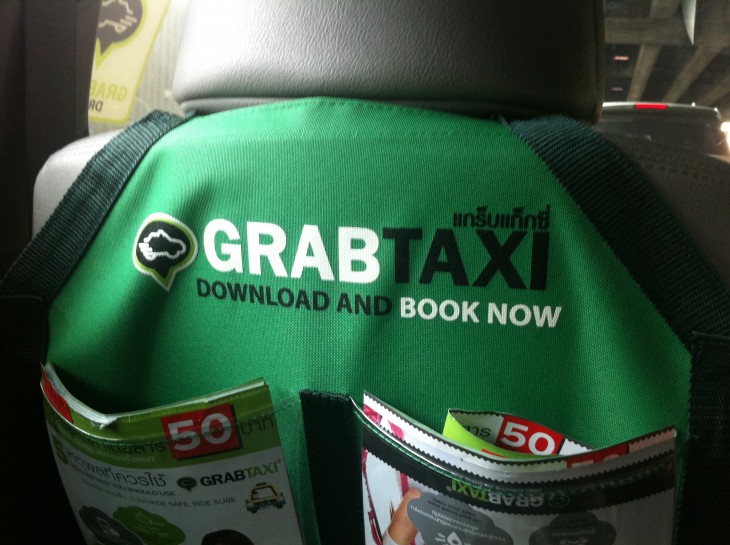
For many passengers in Southeast Asia, getting a taxi that is reliable and safe can be a challenge sometimes. Being overcharged is a common occurrence, while in some cities incidences could even escalate to crimes.
In steps GrabTaxi, essentially a taxi-booking app along the lines of popular car-for-hire service Uber, but with a key difference. Uber is building out its own fleet and emphasizing on premium rides, while GrabTaxi works with the existing taxi ecosystem in the countries it is operating in — namely Malaysia (where it’s known as MyTeksi), the Philippines, Thailand, Vietnam and Singapore.
This also means prices on GrabTaxi are a lot more reasonable, as they are essentially the cost you would have to pay for taking a taxi in these territories — whereas Uber charges a premium for a more luxurious experience. For example, my colleague Jon got a ride via GrabTaxi in Bangkok, Thailand from his home to the airport for under $10, while a same ride on Uber has a flat rate of $33. Even with Uber’s lower-cost UberX service, there is still a premium on the price, even if not as much as its typical service.
The startup aims to provide safe and reliable taxi rides to passengers in the region by being interestingly enough, first and foremost a social enterprise. Founder and CEO Anthony Tan explains to us that doing good makes business sense, which means helping people and building a successful business are no longer mutually exclusive.
The company focuses on two social missions which tie in together: ensuring that drivers make more money on its platform and focusing on the safety of passengers. Tan notes that empirical evidence shows the income of drivers who are active on GrabTaxi’s platform increases between 30 – 300 percent. “By helping them make more money, they become more loyal to the platform, and they help give better customer experience to the passenger,” he says.
What’s more, GrabTaxi suspends taxi drivers who get complaints filed against them by passengers, so the drivers don’t have incentive to behave in ways that could risk a ban. The emphasis on having only drivers who have been rated and passed by customers on GrabTaxi’s platform also relates to safety.
Other measures to ensure security include GrabTaxi’s ‘Share your Ride’ function, which lets users share their journey through social media or messaging apps with friends and family. Users can also track the location of their taxi drivers, and their loved ones on a taxi via the app. Taxi drivers also have their contact numbers keyed into the app, so you can call them anytime.
“Taxi drivers may be perceived as more dangerous (in cities such as Johor Bahru in Malaysia). When we focus on safety for women, that was a clear differentiation point — and that’s what differentiated us from our competitors,” Tan says.
For proof that having a social focus can drive business, GrabTaxi has just secured additional funding from investors including Vertex Venture Holdings. Tan declined to reveal the exact investment figure, only stating that it is an eight–figure sum. Given that earlier this year Vertex Venture launched a $100 million fund to help address the “valley of death” in the Singapore startup scene, and stated that each investment is likely to be between $1 million and $10 million, GrabTaxi’s latest funding should be in the $10 million range.
Tan tells us the funding will go mainly towards hiring talent as GrabTaxi seeks to grow its business in existing markets and tap into new markets in the Southeast Asian region.
The GrabTaxi app has already been downloaded on more than one million mobile devices to date, and there is a taxi booking made through the platform every two seconds across the region. More than 250,000 people use GrabTaxi at least once a month, the company says.
Tan tells TNW that it is the first smartphone-to-smartphone app to land in the region, and it has 15 times more booking volume than its nearest competitors. Though he didn’t name any rivals specifically when asked, the first one that comes to mind is Rocket Internet’s EasyTaxi, available in the region in the very same countries that GrabTaxi operates in — and on top of that, Indonesia and India.
There are also many other native taxi operator booking apps that consumers tend to use, though Tan notes that GrabTaxi employs very different technology compared to them. Taxi booking requests on a native operator app gets routed to an automated machine, whereas GrabTaxi connects drivers to passengers directly. He explains:
We’re all fighting for the same thing: to ensure there’s liquidity. But they just do it in different ways — their way is to buy more cars, get more drivers. It’s a closed loop system. Think of them as more iOS: they want to own the car, own the driver, own the experience, own everything…
We are agnostic. We have no equity, no preferences, nothing. The only thing is our stakeholders — drivers make a lot of money, passengers make sure they get a ride as fast as possible. When you can have that kind of agnosticism and independence, you create a much more liquid market much faster with much smaller investments.
When I called for a taxi via GrabTaxi today, the driver was raving about the app. He told me that compared to native operator apps, GrabTaxi’s location-tracking helps the customer connect more closely with the driver. What’s more, as drivers key in their contact numbers on the app, customers can easily call them. In my case, I immediately gave the driver a ring when I monitored on the map that he had arrived but was nowhere in sight (only then did I realize he was waiting somewhere nearby that I couldn’t spot).
Tan explains how GrabTaxi essentially works as a marketplace: there’s a lot of math involved. “It’s about perishable demand and supply… When you perform a search, the math behind it is tremendous. The query time is very short. It’s about big data,” he says.
First of all, the software needs to be optimized, so this means analyzing the big data to allocate search queries and planning for taxis to be in particular areas at certain timings when they are in higher demand — before customers even press the ‘book’ button.
Another lever to shift the demand curve is price — GrabTaxi acknowledges that it subsidises some rides to try to close the gap between supply and demand during off-peak or peak periods. Consumers in Malaysia, the Philippines, Thailand and Vietnam also have an option of tipping their drivers if they need a taxi urgently. Singapore’s government, however, has made GrabTaxi remove the reward system to ensure its compliance with local regulations, so in the city GrabTaxi is only working based on big data.
Despite the glut of taxi-booking mobile apps in Asia right now, no matter whether premium or layman, native from taxi operators or direct competitors, Tan notes that GrabTaxi is an app built by drivers for drivers.
Why are drivers choosing us more? My great-grandfather was a taxi driver. I drive taxis. Our head of product drives taxis. We built the driver’s app by drivers. That’s the difference.
If you look at the driver’s app, you see the name and the address — it’s huge and in-your-face… Once you press accept, it guides you (via Google Maps). So it helps you drive to get there. We really thought about the experience as drivers, because we are drivers.
Putting issues of competition aside, Tan says that all taxi-booking apps are actually facing the same greatest challenge in their businesses — changing human behavior. “We, with our competitors, are fighting for the same thing: we’re moving and training and guiding and supporting and making it as painless as possible for people to move from a street hail to an e-hail. Our biggest competitor is the average Joe.”
As taxi-booking apps rise in prominence in Asia, we will probably witness a shift from street hailers to e-hailers in the near future — and GrabTaxi is trying its best to be at the center of this revolution.
Headline image via PORNCHAI KITTIWONGSAKUL/AFP/Getty Images
Get the TNW newsletter
Get the most important tech news in your inbox each week.









